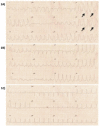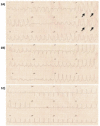Spiked Helmet Sign: An Atypical Case of Transient ST-Segment Elevation on ECG
- PMID: 34133605
- PMCID: PMC8288532
- DOI: 10.36660/abc.20201017
Spiked Helmet Sign: An Atypical Case of Transient ST-Segment Elevation on ECG
Conflict of interest statement
Potencial conflito de interesse
Não há conflito com o presente artigo
Figures




Similar articles
-
The Spiked Helmet Sign Predicting a Poor Outcome in a Patient with Non-Myocardial Infarction ST-Segment Elevation.Medicina (Kaunas). 2021 Nov 1;57(11):1184. doi: 10.3390/medicina57111184. Medicina (Kaunas). 2021. PMID: 34833402 Free PMC article.
-
[Spiked helmet sign ST-segment elevation].Orv Hetil. 2013 Jan 27;154(4):147-9. doi: 10.1556/OH.2013.29523. Orv Hetil. 2013. PMID: 23335725 Hungarian.
-
The 'spiked-helmet' sign in patients with myocardial injury.J Electrocardiol. 2022 Jul-Aug;73:144-147. doi: 10.1016/j.jelectrocard.2020.08.005. Epub 2020 Aug 6. J Electrocardiol. 2022. PMID: 32838962
-
Electrocardiographic Ccharacteristics of metastatic cardiac tumors presenting with ST-segment elevation.J Electrocardiol. 2020 Mar-Apr;59:93-99. doi: 10.1016/j.jelectrocard.2019.12.014. Epub 2019 Dec 26. J Electrocardiol. 2020. PMID: 32035356 Review.
-
The Role of ECG in the Diagnosis and Risk Stratification of Acute Coronary Syndromes: an Old but Indispensable Tool.Curr Cardiol Rep. 2022 Feb;24(2):109-118. doi: 10.1007/s11886-021-01628-7. Epub 2022 Jan 13. Curr Cardiol Rep. 2022. PMID: 35028816 Review.
Cited by
-
Spiked Helmet Sign: An Uncommon Electrocardiographic Marker.Rev Cardiovasc Med. 2023 Sep 25;24(9):272. doi: 10.31083/j.rcm2409272. eCollection 2023 Sep. Rev Cardiovasc Med. 2023. PMID: 39076406 Free PMC article. Review.
References
-
- 2. Darek C, Hoshiar A, Adrian B. An ominous ECG signal in critical care. Circulation 2020;141:2106-9. - PubMed
-
- 3. Laundon RK, Littmann L. Spiked helmet pattern ST elevation in subarachnoid hemorrhage. J Eletrocardiol 2019;52:96-8. - PubMed
-
- 4. Aliyev F, Abdulkerimov V, Gul EE, Samedov F, Isayev E, Ferecov E. Spiked helmet sign after percutaneous left stellate ganglion ablation in a patient with long QT syndrome. J Eletrocardiol 2017;50(6):944-6. - PubMed
-
- 5. Samadov F, Gasimov E, Aliyev F, Isayev E. Yhe “spiked helmet” sign – a potencial relationship to Takotsubo cardiomyopathy. Am J Emerg Med 2018;36(2) [345 e345-345 e347]. - PubMed
Publication types
MeSH terms
LinkOut - more resources
Full Text Sources
Medical

